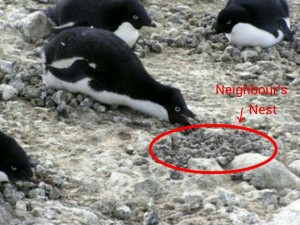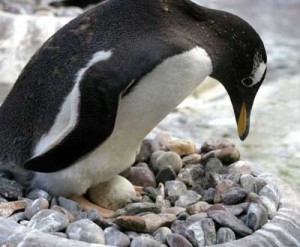Criminals in tuxs
 Penguins are not as simple as we think. Adelie penguins, otherwise known as Pygoscelis adeliae are the smallest of the Antarctic penguins. Yet, these Adelie penguins are known for being “Thief penguins” as they would be sneaking around their neighbour’s stones and waiting for the opportunity to steal them (National Geographic, 1996; Davies, 1959). Here is a video of a penguin that was caught in the act:
Penguins are not as simple as we think. Adelie penguins, otherwise known as Pygoscelis adeliae are the smallest of the Antarctic penguins. Yet, these Adelie penguins are known for being “Thief penguins” as they would be sneaking around their neighbour’s stones and waiting for the opportunity to steal them (National Geographic, 1996; Davies, 1959). Here is a video of a penguin that was caught in the act:
 http://www.youtube.com/watch?v=LbTZg5TGM1c
http://www.youtube.com/watch?v=LbTZg5TGM1c
Secondly, females penguins were actually observed to be willing to go all out to get these stones by copulating with other unpaired males, without their “husband’s” knowledge (Hunter & Davis, 1998). This is surprising as referencing to the study by Andrew and Roberts, penguins are monogamous as adult penguins will return to the same nest and maintain the same pair-bond even after a winter among the pack-ice (Sladen, 1953). After copulation, the females would be able to take a stone from his nest. Based on an observation of 10 female penguins, 5 actually managed to take a second stone and were not stopped even though they copulated only once with that male penguin. BBC has noticed this prostitution behaviour as seen from the following video: http://www.youtube.com/watch?v=tAgAim926s0
 As seen from above, these stones are extremely valuable to the Adelie penguins as they are used for two important purposes: to attract a mate and it is used as nesting material. The male penguin takes care of the egg on top of his nest built of stones. (Dembsky, 2006) Stones are crucial for protecting the eggs due to unfavourable externalities such as watchful scavengers or the harsh conditions during springtime when melt-water can easily inundate the whole breeding colony (Hunter & Davis, 1998). Hence, to ensure reproductive successes, these penguins would do the unthinkable. In addition, the stone is used as a present that the male penguin would offer, when an attractive female penguin catches his eye. If the stone is accepted, they will start a pair-bond and mate. This is similar to humans in expressing their loves for each other with a special gift.
As seen from above, these stones are extremely valuable to the Adelie penguins as they are used for two important purposes: to attract a mate and it is used as nesting material. The male penguin takes care of the egg on top of his nest built of stones. (Dembsky, 2006) Stones are crucial for protecting the eggs due to unfavourable externalities such as watchful scavengers or the harsh conditions during springtime when melt-water can easily inundate the whole breeding colony (Hunter & Davis, 1998). Hence, to ensure reproductive successes, these penguins would do the unthinkable. In addition, the stone is used as a present that the male penguin would offer, when an attractive female penguin catches his eye. If the stone is accepted, they will start a pair-bond and mate. This is similar to humans in expressing their loves for each other with a special gift.
Literature cited:
- “Penguin facts,” by J. Dembsky, Sep 2006. URL: http://users.tellurian.net/teach/penguins/facts.html (accessed on 2 Apr 2013)
- “Adélie Penguin,” by National Geographic, 1996-2013. URL: http://animals.nationalgeographic.com/animals/birds/adelie-penguin/ (accessed on 2 Apr 2013)
- “The Adelie Penguin,” by Dr, W.J. L. Sladen, 30 May 1953. URL: http://www.nature.com.libproxy1.nus.edu.sg/nature/journal/v171/n4361/pdf/171952a0.pdf (accessed on 2 Apr 2013)
- J. H. Wilkinson & D. W. Davies, 1959. The Adelie Penguins. Nature 183, vol 183, p. 24
- F. M. Hunter & L. S. Davies, 1998. Female Adelie Penguins Acquire Nest Material from Extrapair Males afrer Engaging in Extrapair Copulations. The Ark 115(2):526
Videos cited:
1.“Penguin steal stones from neighbor’s nest!,” by madhatneus Youtube Channel,19 Oct 2011. URL: http://www.youtube.com/watch?v=LbTZg5TGM1c (accessed on 2 Apr 2013)
2. “Penguin prostitution-Deep into the Wild-BBC,” by BBCEarth Youtube Channel, 31 Aug 2010. URL: http://www.youtube.com/watch?v=tAgAim926s0 (accessed on 2 Apr 2013)
Photos used:
- “Adelie hatchling with parent,” by Doug Allan. Arkive. URL: http://www.arkive.org/adelie-penguin/pygoscelis-adeliae/image-G39981.html
- “The truth about Penguins,” by Tania Whillot. Wakkipedia, 10 Jun 2012. URL: http://www.wakkipedia.com/newsitem/173/the-truth-about-penguins/
- “Adelie penguins,” by Viola & Grant. Antartic journal, 18 Jan 2006. URL: http://antarcticjournal.blogspot.sg/2006/01/adelie-penguins.html